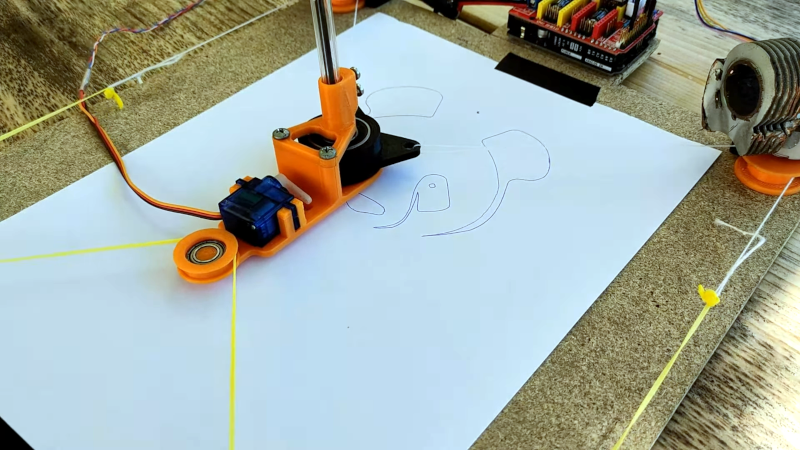Sure, we see quite a few plotters and other motion machines, but the one from [DAZ Projects] has the virtual of looking dead simple. The Arduino and CNC shield are old hat, of course. But some 3D printed pulleys and a very simple-looking core XY arrangement looks like this could be a pretty quick build.
You might ask; if you have a 3D printer, why you wouldn’t just mount a pen on it and call it a day? Well, you could do that, of course, but what fun is that? Besides, that will tie up your printer, too. You can see a video of the project, below.
The build looks inexpensive using just a few bearings and motors. Most of it looks like things you probably have hanging around such as strings and rubber bands with some scrap lumber. We enjoyed how the play in the motion mechanism allowed an RC servo to easily lift the whole pen off the sheet. Of course, the pen or the servo horn slides across the paper, so we don’t think you could easily hang a laser module to make an engraver, although we don’t doubt you could figure something out.
We can tell [DAZ] likes to make motion-based projects. We also thought this reminded us of a whiteboard plotter we saw recently.
















Guess it wouldnt be hard to add a cutter to it.
Or a laser. Even a fricking one.
Very nice. Similar to the wall-mounted string plotter here:
https://www.hackster.io/fredrikstridsman/stringent-the-15-wall-plotter-d965ca
I think that’s the point, with the rubber band taking the place of gravity, which is an inspired choice.
The problem in practice with the free-hanging ones is that you need to go slowly b/c otherwise it pendulums on the lines. And you also can’t go too far toward either edge b/c the tension on the opposing side drops to zero.
By adding a counter-spring like this, especially if they were slightly out of frame, it would let you use more of the sheet. And if the rubber band will reduce the swinging.
This would be useful even in a gravity-hanging one, IMO.
you wouldn’t mount a pen on your 3D printer because their bed s typically tiny, when it comes to engineering drawings A4 is considered only for the most simple of objects. Think L bracket. A2, A1 are far more common but really even they are considered small. Check with your garage builder and see what the working drawings are printed on. I bet it would make most privateer 3D printers blush. On the other hand this project is far more flexible and could potentially…..
i guess for large accurate cad drawings, a drum plotter is still the best option. Dimensions are only restricted by the width of your build and the pen can be positioned by timing belt, a lead screw pr even rack and pinion if you need the accuracy over the complete width
murals and other art….same
There’s no reason you couldn’t cut all the plastic parts out of wood, with very little modification to the design.
A sheet of appropriately thick plywood is indeed the hackers delight. Until 3D printers took over that is…
Plastic has some advantages in regards to dimensional stability, not to mention not warping if getting drenched.
But plywood is still something I at least use every now and then, though I don’t have a 3D printer yet….
nice,
but why use simple rope not 10mm wide timing belt? or https://domero.pl/oslony-okienne/akcesoria-do-rolet/lancuszek-do-rolet-45mm
Could also use Delrin for the base… And use a 32 bit board, etc. etc.
My guess: availability and cost. Those are the cheapest, most widely available parts you can use in a design. :)
Bravo Davide!!
As someone who started loooong ago to build vertical plotters to make big installations (up to 5m x 5m with a single plotter), I am _very_ impressed by your clever idea of the moving rubber bands.
Kudos to you and keep up the good work!
Antonio
It Seems like the polargraph on a table with the third direction being a motor (that option was optional, as options often are), when i got my polargraph. Its a really nifty piece of machine though. Impressive.